Differences between Outdoor and Indoor Sound Levels for Open, Tilted, and Closed Windows
Abstract
:1. Introduction
2. Methods
2.1. Measurements
2.2. Calculation of the Sound Level Differences between the Outdoors and Indoors
2.3. Statistical Analyses
3. Results
3.1. A-Weighted Sound Level Differences between Outdoors and Indoors
3.2. Spectral Sound Level Differences between the Outdoors and Indoors
3.3. Linear Regression Model for Open and Tilted Windows
3.4. Linear Regression Model for Closed Windows
4. Discussion
4.1. Sound Level Differences between the Outdoors and Indoors
- A comparison of the values for open window situations shows in general a good agreement between the different studies, with a range of levels from 10 to 13 dB(A). The deviation between the resulting averages is rather small, when comparing it with the substantial spread of the individual values within the studies.
- For tilted windows the resulting outside–inside differences are slightly greater, ranging from 14 to 19 dB(A). However, the results between the studies still look consistent. The additional sound insulation effect of a tilted window compared to an opened one can consequently be deduced as 4–6 dB(A) on average.
- For closed window situations, the resulting averages between the different studies are rather close, ranging from 26 to 31 dB(A). Hence, the effect of closing windows, compared to an open window situation, results on average in a level decrease inside the building of 16–18 dB(A).
- We are convinced that the angle of sound incidence, in combination with the orientation of the opening of the window, is primarily responsible for the stated source-specific effects.
- The window size and the opening angle define the opening area available for the sound passage and hence the incoming sound intensity.
- The level inside is not only defined by the incoming sound intensity but also by the room acoustic conditions in the receiving room, primarily the reverberation time and the room size.
4.2. Linear Regression Model for Open and Tilted Windows
4.3. Linear Regression Model for Closed Windows
5. Relevance and Applicability
6. Conclusions
Acknowledgments
Author Contributions
Conflicts of Interest
References
- Recio, A.; Linares, C.; Banegas, J.R.; Díaz, J. Road traffic noise effects on cardiovascular, respiratory, and metabolic health: An integrative model of biological mechanisms. Environ. Res. 2016, 146, 359–370. [Google Scholar] [CrossRef] [PubMed]
- Pirrera, S.; Valck, E.D.; Cluydts, R. Field study on the impact of nocturnal road traffic noise on sleep: The importance of in- and outdoor noise assessment, the bedroom location and nighttime noise disturbances. Sci. Total Environ. 2014, 500–501, 84–90. [Google Scholar] [CrossRef] [PubMed]
- Frei, P.; Mohler, E.; Röösli, M. Effect of nocturnal road traffic noise exposure and annoyance on objective and subjective sleep quality. Int. J. Hyg. Environ. Health 2014, 217, 188–195. [Google Scholar] [CrossRef] [PubMed]
- Basner, M.; Babisch, W.; Davis, A.; Brink, M.; Clark, C.; Janssen, S.; Stansfeld, S. Auditory and non-auditory effects of noise on health. Lancet 2014, 383, 1325–1332. [Google Scholar] [CrossRef]
- Brink, M. A review of potential mechanisms in the genesis of long-term health effects due to noise-induced sleep disturbances. In Proceedings of the INTER-NOISE 2012, New York, NY, USA, 19–22 August 2012. [Google Scholar]
- Eze, I.C.; Foraster, M.; Schaffner, E.; Vienneau, D.; Héritier, H.; Rudzik, F.; Thiesse, L.; Pieren, R.; Imboden, M.; von Eckardstein, A.; et al. Long-term exposure to transportation noise and air pollution in relation to incident diabetes in the SAPALDIA study. Int. J. Epidemiol. 2017, 46, 1115–1125. [Google Scholar] [CrossRef] [PubMed]
- Héritier, H.; Vienneau, D.; Foraster, M.; Eze, I.C.; Schaffner, E.; Thiesse, L.; Rudzik, F.; Habermacher, M.; Köpfli, M.; Pieren, R.; et al. Transportation noise exposure and cardiovascular mortality: A nationwide cohort study from Switzerland. Eur. J. Epidemiol. 2017, 32, 307–315. [Google Scholar] [CrossRef] [PubMed]
- Amundsen, A.H.; Klaeboe, R.; Aasvang, G.M. The Norwegian Facade Insulation Study: The efficacy of facade insulation in reducing noise annoyance due to road traffic. J. Acoust. Soc. Am. 2011, 129, 1381–1389. [Google Scholar] [CrossRef] [PubMed]
- Amundsen, A.H.; Klaeboe, R.; Aasvang, G.M. Long-term effects of noise reduction measures on noise annoyance and sleep disturbance: The Norwegian facade insulation study. J. Acoust. Soc. Am. 2013, 133, 3921–3928. [Google Scholar] [CrossRef] [PubMed]
- Foraster, M.; Künzli, N.; Aguilera, I.; Rivera, M.; Agis, D.; Vila, J.; Bouso, L.; Deltell, A.; Marrugat, J.; Ramos, R.; et al. High blood pressure and long-term exposure to indoor noise and air pollution from road traffic. Environ. Health Perspect. 2014, 122, 1193–1200. [Google Scholar] [CrossRef] [PubMed]
- Schreckenberg, D. Exposure-response relationship for railway noise annoyance in the Middle Rhine Valley. In Proceedings of the INTER-NOISE and NOISE-CON Congress and Conference Proceedings, Innsbruck, Austria, 15–18 September 2013. [Google Scholar]
- Öhrström, E.; Skånberg, A.; Svensson, H.; Gidlöf-Gunnarsson, A. Effects of road traffic noise and the benefit of access to quietness. J. Sound Vib. 2006, 295, 40–59. [Google Scholar] [CrossRef]
- Griefahn, B.; Schuemer-Kohrs, A.; Schuemer, R.; Moehler, U.; Mehnert, P. Physiological, subjective, and behavioural responses to noise from rail and road traffic. Noise Health 2000, 3, 59–71. [Google Scholar] [PubMed]
- Röösli, M.; Vienneau, D. Epidemiological exposure assessment. In Epidemiology of Electromagnetic Fields—An Application of Environmental Epidemiological Methods; Röösli, M., Ed.; CRC Press, a Taylor & Francis Company: Boca Raton, FL, USA, 2014; pp. 37–58. [Google Scholar]
- Ryan, M.; Lanchester, M.; Pugh, S. Noise Reduction through Facades with Open Windows. Paper Number 37. In Proceedings of the ACOUSTICS, Gold Coast, Australia, 2–4 November 2011. [Google Scholar]
- Müller, U. Sound level measurement of aircraft and vehicle noise, simultaneously recorded at facades and the sleeper’s ear. In Proceedings of the Euronoise 2006, Tampere, Finland, 30 May–6 June 2006. [Google Scholar]
- Basner, M.; Müller, U.; Samel, A. Nachtfluglärmwirkungen (Band 2): Methodik, Akustik. DLR-Forschungsbericht 2004-08/D; Technical Report; Institut für Luft- und Raumfahrtmedizin des DLR: Köln, Germany, 2004. [Google Scholar]
- Müller, U.; Basner, M.; Samel, A. DEUFRAKO/RAPS—Railway Noise (and Other Modes) Annoyance, Performance, Sleep. Wirkungsorientierte Bewertung Unterschiedlicher Verkehrslärmarten. Teilvorhaben DLR: Metaanalyse und Feldstudie. Abschlussbericht; Technical Report; Deutsches Zentrum für Luft- und Raumfahrt: Cologne, Germany, 2010. [Google Scholar]
- Jansen, G.; Linnemeier, A.; Nitzsche, M. Methodenkritische Überlegungen und Empfehlungen zur Bewertung von Nachtfluglärm. Z. Lärmbekämpfung 1995, 42, 91–106. [Google Scholar]
- BUWAL. Belastungsgrenzwerte Für den Lärm der Landesflughäfen. Schriftenreihe Umwelt Nr. 296. 1998. Available online: https://www.bafu.admin.ch/bafu/de/home/themen/laerm/publikationen-studien/publikationen/belastungsgrenzwerte-laerm-landesflughaefen.html (accessed on 3 March 2017).
- Maschke, C.; Volz, R.; Jakob, A.; Augustin, E. Pegeldifferenzen Gekippt-Geöffneter Fenster bei Fluglärm—Messungen nach DIN EN ISO 140-5 Gesamt-Lautsprecher-Verfahren; Deutsche Gesellschaft für Akustik e.V (DEGA) (German Society for Acoustics (DEGA): Berlin, Germany, 2010. [Google Scholar]
- EEA. Good Practice Guide on Noise Exposure and Potential Health Effects; Technical Report; European Environment Agency: Copenhagen, Denmark, 2010; Available online: https://www.eea.europa.eu/publications/good-practice-guide-on-noise (accessed on 16 August 2017).
- Granzotto, N.; Bettarello, F.; Ferluga, A.; Marsich, L.; Schmid, C.; Fausti, P.; Caniato, M. Energy and acoustic performances of windows and their correlation. Energy Build. 2017, 136, 189–198. [Google Scholar] [CrossRef]
- Buratti, C. Indoor noise reduction index with open window. Appl. Acoust. 2002, 63, 431–451. [Google Scholar] [CrossRef]
- Jean, P. Sound transmission through opened windows. Appl. Acoust. 2009, 70, 41–49. [Google Scholar] [CrossRef]
- Tong, Y.G.; Tang, S.K.; Kang, J.; Fung, A.; Yeung, M.K.L. Full scale field study of sound transmission across plenum windows. Appl. Acoust. 2015, 89, 244–253. [Google Scholar] [CrossRef]
- Licitra, G.; Fredianelli, L.; Petri, D.; Vigotti, M.A. Annoyance evaluation due to overall railway noise and vibration in Pisa urban areas. Sci. Total Environ. 2016, 568, 1315–1325. [Google Scholar] [CrossRef] [PubMed]
- Pabst, F. Massnahmenkonzept zum Zürcher Flughafen-Index (ZFI). Projektgruppe “Raumentwicklung/ Wohnqualität”. Fragenbeantwortung im Rahmen der Studie “Bauqualität und Schalldämmung”; Volkswirtschaftsdirektion Kanton Zürich: Zürich, Switzerland, 2009. [Google Scholar]
- Scamoni, F.; Scrosati, C. The facade sound insulation and its classification. In Proceedings of the Forum Acusticum, Kraków, Poland, 7–12 September 2014; p. 6. [Google Scholar]
- Secchi, S.; Astolfi, A.; Calosso, G.; Casini, D.; Cellai, G.; Scamoni, F.; Scrosati, C.; Shtrepi, L. Effect of outdoor noise and façade sound insulation on indoor acoustic environment of Italian schools. Appl. Acoust. 2017, 126, 120–130. [Google Scholar] [CrossRef]
- Pinho, P.G.; Pinto, M.; Almeida, R.M.S.F.; Lopes, S.M.; Lemos, L.T. Aspects concerning the acoustical performance of school buildings in Portugal. Appl. Acoust. 2016, 106, 129–134. [Google Scholar] [CrossRef]
- Puglisi, G.E.; Cutiva, L.C.C.; Pavese, L.; Castellana, A.; Bona, M.; Fasolis, S.; Lorenzatti, V.; Carullo, A.; Burdorf, A.; Bronuzzi, F.; et al. Acoustic Comfort in High-school Classrooms for Students and Teachers. Energy Procedia 2015, 78, 3096–3101. [Google Scholar] [CrossRef] [Green Version]
- Dongre, A.R.; Patil, A.P.; Wahurwagh, A.J.; Kothari, A.; Burchundi, K.; Manohare, M.P. Acoustical characteristics of classrooms of tropical climate. Appl. Acoust. 2017, 121, 46–55. [Google Scholar] [CrossRef]
- Sala, E.; Rantala, L. Acoustics and activity noise in school classrooms in Finland. Appl. Acoust. 2016, 114, 252–259. [Google Scholar] [CrossRef]
- Mealings, K.T.; Buchholz, J.M.; Demuth, K.; Dillon, H. Investigating the acoustics of a sample of open plan and enclosed Kindergarten classrooms in Australia. Appl. Acoust. 2015, 100, 95–105. [Google Scholar] [CrossRef]
- Locher, B.; Piquerez, A.; Habermacher, M.; Ragettli, M.; Röösli, M.; Brink, M.; Cajochen, C.; Probst Hensch, N.; Foraster, M.; Wunderli, J. A statistical model to predict sound level differences between in- and outdoors. In Proceedings of the ICBEN 2017, Zürich, Switzerland, 18–22 June 2017. [Google Scholar]
- Karipidis, I.; Vienneau, D.; Habermacher, M.; Köpfli, M.; Brink, M.; Probst-Hensch, N.; Röösli, M.; Wunderli, J.M. Reconstruction of historical noise exposure data for environmental epidemiology in Switzerland within the SiRENE project. Noise Mapp. 2014, 1. [Google Scholar] [CrossRef]
- Brink, M.; Schreckenberg, D.; Vienneau, D.; Cajochen, C.; Wunderli, J.M.; Probst-Hensch, N.; Röösli, M. Effects of scale, question location, order of response alternatives, and season on self-reported noise annoyance using icben scales: A field experiment. Int. J. Environ. Res. Public Health 2016, 13, 1163. [Google Scholar] [CrossRef] [PubMed]
- Schlatter, F.; Piquerez, A.; Habermacher, M.; Ragettli, M.; Röösli, M.; Brink, M.; Cajochen, C.; Probst-Hensch, N.; Foraster, M.; Wunderli, J. Validation of large scale noise exposure modelling by long-term measurements. Noise Mapp. 2017, 4, 75–86. [Google Scholar] [CrossRef]
- Tukey, J. Exploratory Data Analysis; Addison-Wesley Pub. Co.: Reading, MA, USA, 1977. [Google Scholar]
- Kephalopoulos, S.; Paviotti, M.; Anfosso–Lédée, F. Common Noise Assessment Methods in Europe (CNOSSOS—EU); Technical Report; European Union: Brussels, Belgium, 2012. [Google Scholar]
- Kötz, W.D. Zur Frage der effektiven Schalldämmung von geöffneten Fenstern. Z. Lärmbekämpfung 2004, 51, 21–26. [Google Scholar]
- Buratti, C.; Belloni, E.; Moretti, E. Façade noise abatement prediction: New spectrum adaptation terms measured in field in different road and railway traffic conditions. Appl. Acoust. 2014, 76, 238–248. [Google Scholar] [CrossRef]
- SIA 181. Schallschutz im Hochbau; Schweizer Norm SN 520 181; Schweizerischer Ingenieur- und Architektenverein: Zürich, Switzerland, 2006. [Google Scholar]
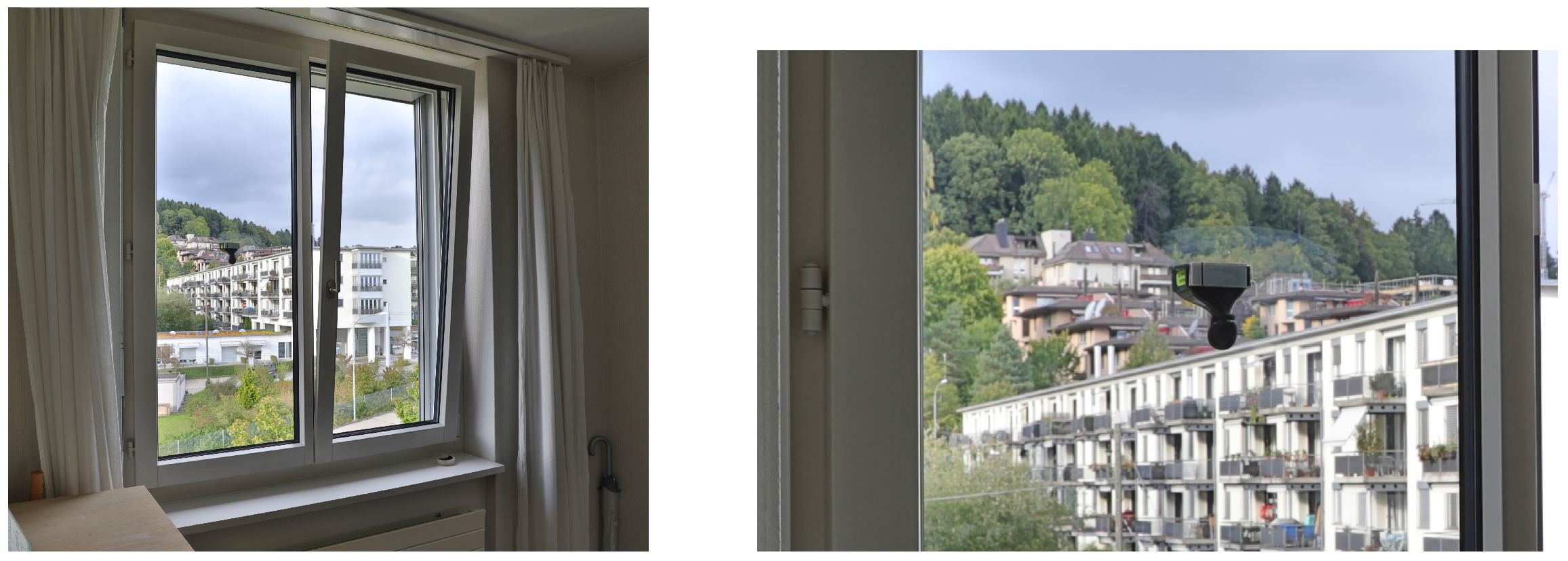
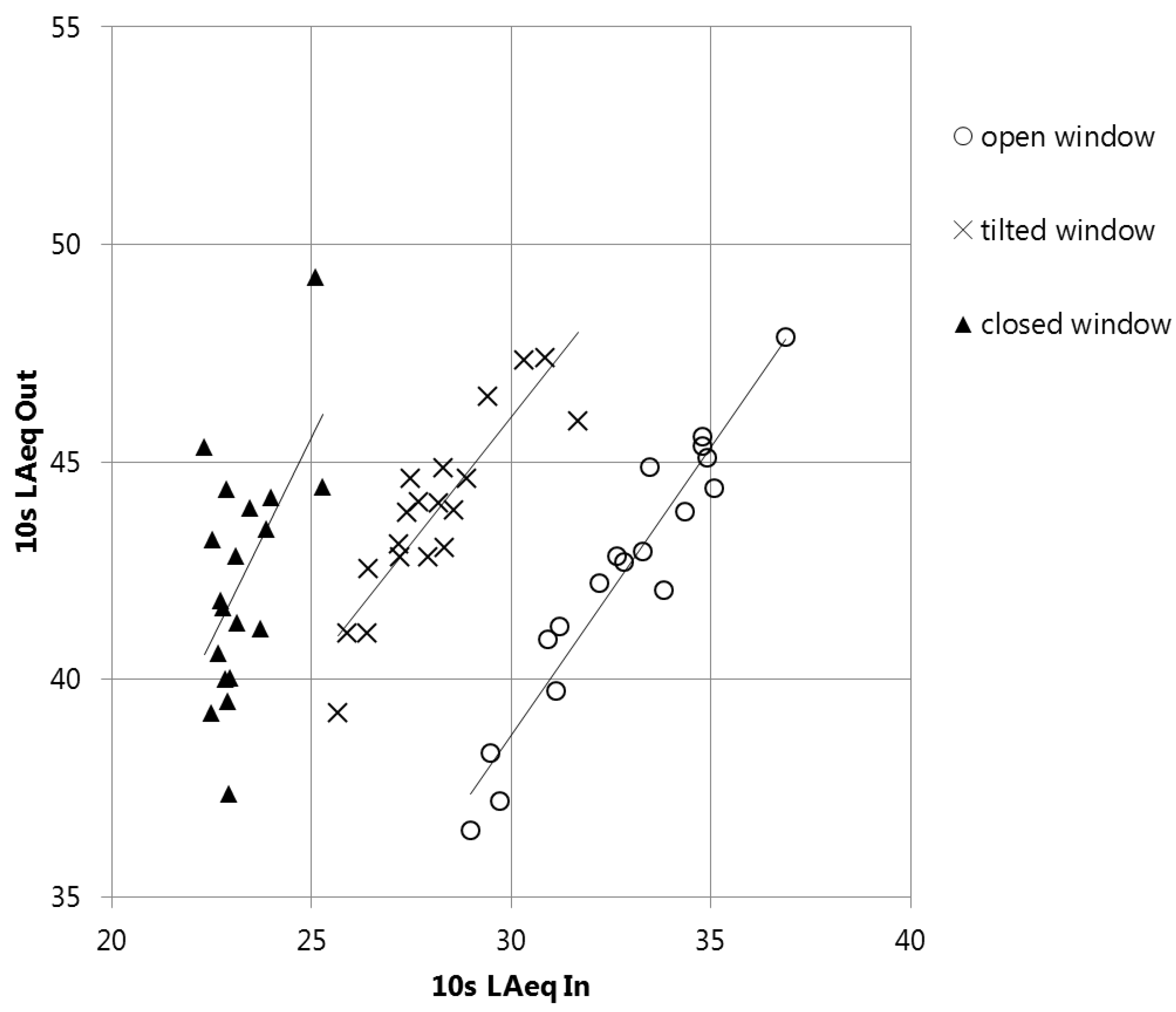
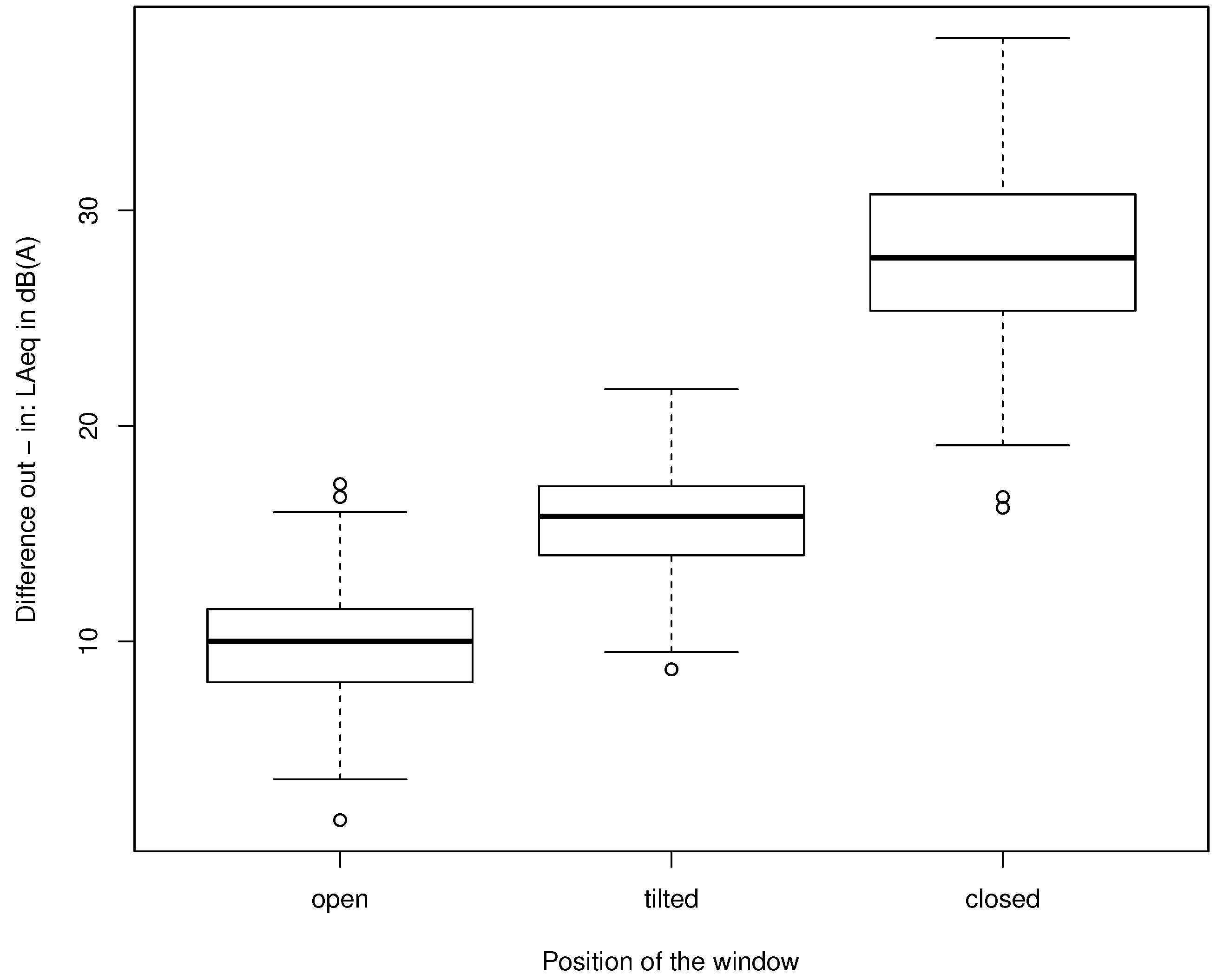
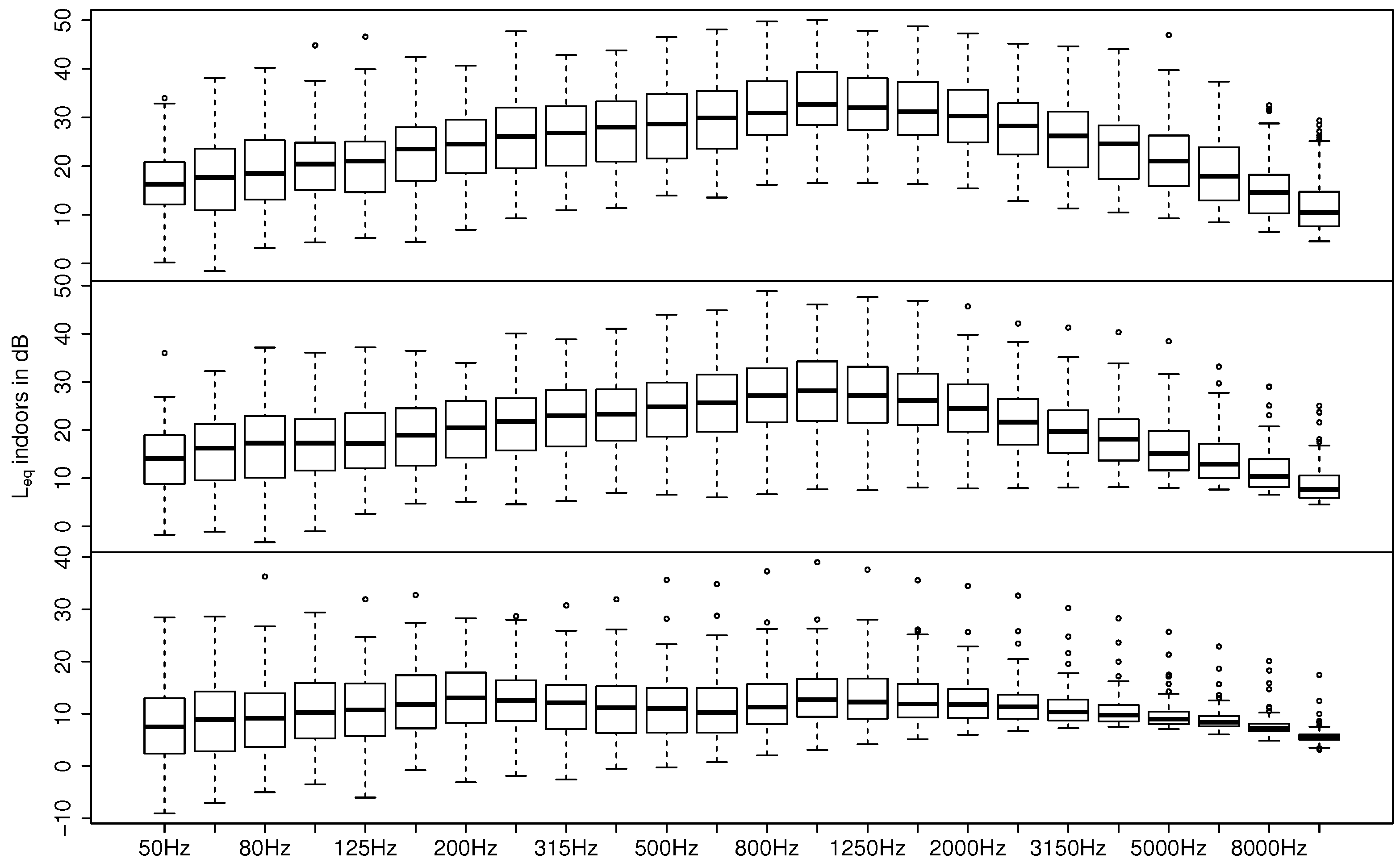
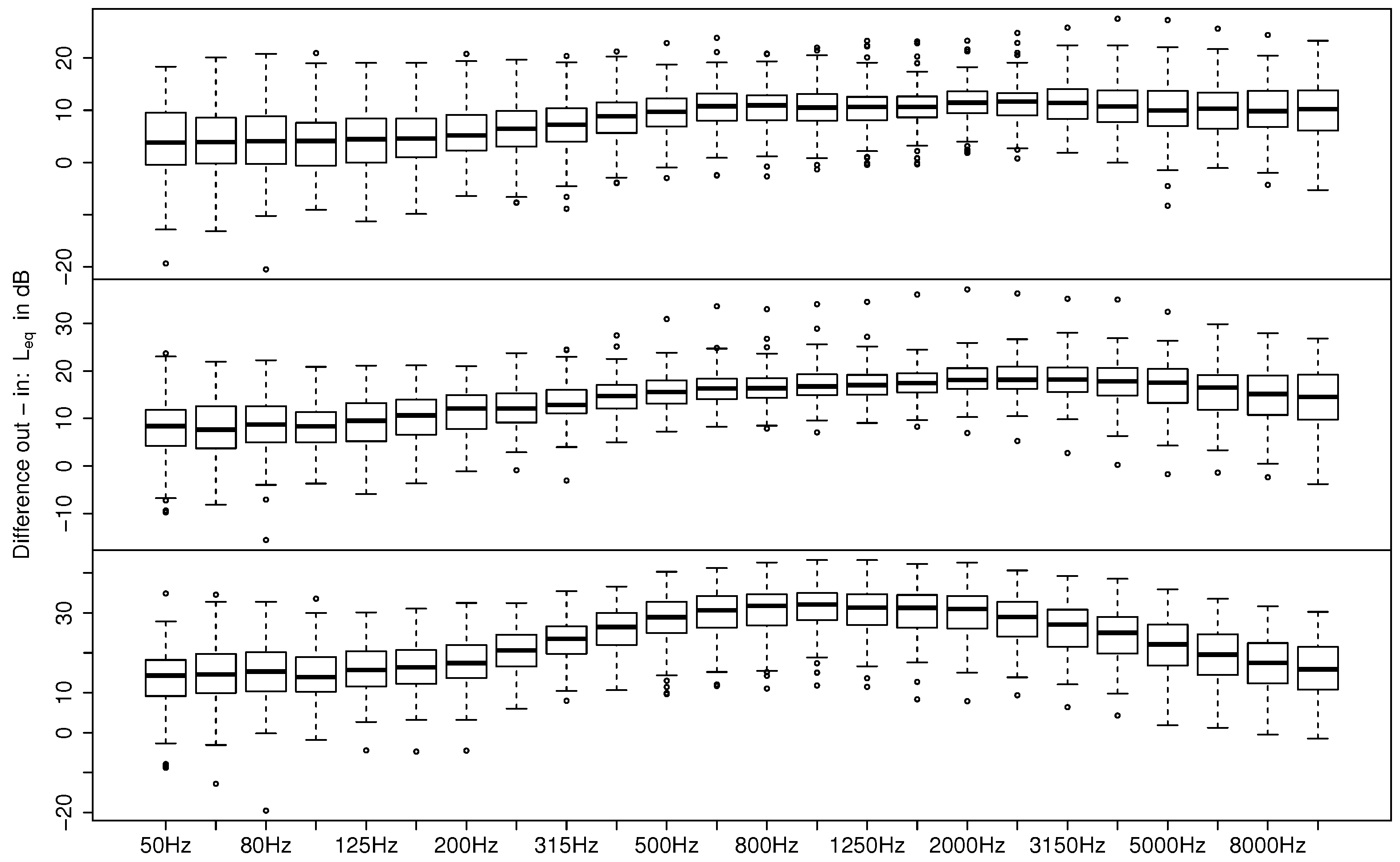

| Parameter | Type | Levels | No. of Levels |
|---|---|---|---|
| Window position | Categorical | Open, tilted, closed | 3 |
| Floor level | Continuos | 0, 1, 2, etc. | - |
| Room type | Categorical | Sleeping room, living room, kitchen/dining room | 3 |
| Orientation of window towards source | Categorical | frontal, lateral (), opposite side | 3 |
| Distance to source | Continuous | Distance in m | - |
| Microphone position inside | Categorical | Corner, close to wall, free in the room | 3 |
| Distance microphone inside-window | Continuous | Distance in m | - |
| Window-frame | Categorical | Wood, synthetic material, metal | 3 |
| Existence of window gaskets | Categorical | yes, no, unknown | 3 |
| Condition of window gaskets | Categorical | Good, mediocre, bad, unknown | 4 |
| No. of window glasses | Categorical | Single, double, triple glazing | 3 |
| Type of window | Categorical | 1 sash (moveable part of the window), 2 sashes | 2 |
| Type of façade | Categorical | Façade with single windows, band of windows, glass front | 3 |
| No. of windows in room | Continuous | 1, 2, 3, etc. | - |
| Proportion of glazed area | Continuous | Percentage, relative to the wall area | - |
| Volume of the room | Categorical | <15, 15–35, 35–60, 60–150 m | 4 |
| Type of building | Categorical | single-family house, detached apartment building, continuous block of flats | 3 |
| Age of building | Categorical | >40, 20–40, <20 years, unknown | 4 |
| Period of renovation | Categorical | 1971–1980, 1981–1990, 1991–2000, not renovated, unknown | 5 |
| Aeration | Categorical | Window ventilation, artificial ventilation | 2 |
| Room characteristics | Categorical | Corner room, top floor with pitched roof area, other | 3 |
| Window Position | Number of Measurements | ||||
|---|---|---|---|---|---|
| Median (25%, 75% Quantile) | Min | Max | SD | ||
| open | 10.0 (8.1, 11.5) | 1.7 | 17.3 | 2.9 | 115 |
| tilted | 15.8 (14.0, 17.2) | 8.7 | 21.7 | 2.7 | 116 |
| closed | 27.8 (25.4, 30.8) | 16.2 | 38.0 | 4.4 | 76 |
| all | 307 | ||||
| Parameter | Symbol in Equation (1) | Coeff. | 95% CI | Std. Error | t Value | (>|t|) |
|---|---|---|---|---|---|---|
| Intercept | 8.5 | 0.5 | 16.8 | <0.001 | ||
| Window position | window = open | 0 | ||||
| window = tilted | 6.1 | [5.4; 6.7] | 0.3 | 19.1 | ||
| Room | room = bedroom | 0 | ||||
| room = kitchen/dining room | −5.1 | [−7.3; −2.9] | 1.1 | −4.5 | <0.001 | |
| room = living room | −1.1 | [−1.9; −0.4] | 0.4 | −3.0 | 0.003 | |
| Room volume | V = <60 m | 0 | ||||
| V = 60–150 m | 1.2 | [0.2; 2.1] | 0.5 | 2.4 | 0.018 | |
| Age of building | age < 20 years | 0 | ||||
| age = 20–40 years | 1.7 | [0.7; 2.7] | 0.5 | 3.3 | 0.001 | |
| age > 40 years | 1.9 | [0.9; 2.9] | 0.5 | 3.7 | <0.001 |
| Parameter | Symbol in Equation (2) | Coeff. | 95% CI | Std. Error | t Value | (>|t|) |
|---|---|---|---|---|---|---|
| Intercept | .03 | [−9.2; 3.2] | 3.11 | −1.0 | 0.334 | |
| Number of windows | −0.93 | [−1.7; −0.16] | 0.38 | −2.4 | 0.018 | |
| outdoors | 0.55 | [0.4; 0.7] | 0.05 | 10.2 | <0.001 | |
| Material of the window-frame | frame = wood | 0 | ||||
| frame = synthetic/metal | 1.91 | [0.7; 3.1] | 0.59 | 3.2 | 0.002 | |
| Existence window gaskets | gaskets = yes | 0 | ||||
| gaskets = no | −2.32 | [−4.6; 0.0] | 1.15 | −2.0 | 0.050 |
| Window Position | This Study | DLR 2010 [18] | DLR 2006 [16] | Scamoni 2014 [29] | Ryan 2011 [15] | Maschke 2010 [21] | BUWAL 1998 [20] | |||
|---|---|---|---|---|---|---|---|---|---|---|
| Freight Trains | Passenger Trains | Road | Road | Aircraft | Reference Road | Road | Aircraft | Aircraft | ||
| open | 10.0 (115) | 11.3 (4) | 11.9 (4) | 11.6 (4) | 13.4 (4) | 10.0 (4) | 10.7 (11) | |||
| tilted | 15.8 (116) | 18.6 (10) | 18.0 (10) | 17.7 (10) | 13.7 (32) | 15.3 (32) | 12 | 15 | ||
| closed | 27.8 (76) | 30.1 (13) | 29.7 (13) | 30.1 (13) | 27.0 (15) | 25.6 (15) | 31.2 (334) | 25 | ||
© 2018 by the authors. Licensee MDPI, Basel, Switzerland. This article is an open access article distributed under the terms and conditions of the Creative Commons Attribution (CC BY) license (http://creativecommons.org/licenses/by/4.0/).
Share and Cite
Locher, B.; Piquerez, A.; Habermacher, M.; Ragettli, M.; Röösli, M.; Brink, M.; Cajochen, C.; Vienneau, D.; Foraster, M.; Müller, U.; et al. Differences between Outdoor and Indoor Sound Levels for Open, Tilted, and Closed Windows. Int. J. Environ. Res. Public Health 2018, 15, 149. https://doi.org/10.3390/ijerph15010149
Locher B, Piquerez A, Habermacher M, Ragettli M, Röösli M, Brink M, Cajochen C, Vienneau D, Foraster M, Müller U, et al. Differences between Outdoor and Indoor Sound Levels for Open, Tilted, and Closed Windows. International Journal of Environmental Research and Public Health. 2018; 15(1):149. https://doi.org/10.3390/ijerph15010149
Chicago/Turabian StyleLocher, Barbara, André Piquerez, Manuel Habermacher, Martina Ragettli, Martin Röösli, Mark Brink, Christian Cajochen, Danielle Vienneau, Maria Foraster, Uwe Müller, and et al. 2018. "Differences between Outdoor and Indoor Sound Levels for Open, Tilted, and Closed Windows" International Journal of Environmental Research and Public Health 15, no. 1: 149. https://doi.org/10.3390/ijerph15010149
APA StyleLocher, B., Piquerez, A., Habermacher, M., Ragettli, M., Röösli, M., Brink, M., Cajochen, C., Vienneau, D., Foraster, M., Müller, U., & Wunderli, J. M. (2018). Differences between Outdoor and Indoor Sound Levels for Open, Tilted, and Closed Windows. International Journal of Environmental Research and Public Health, 15(1), 149. https://doi.org/10.3390/ijerph15010149









